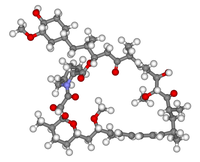
Photo from wikipedia
BackgroundMYCN amplification or N-Myc overexpression is found in approximately 40% NEPC and up to 20% CRPC patients. N-Myc has been demonstrated to drive disease progression and hormonal therapeutic resistance of… Click to show full abstract
BackgroundMYCN amplification or N-Myc overexpression is found in approximately 40% NEPC and up to 20% CRPC patients. N-Myc has been demonstrated to drive disease progression and hormonal therapeutic resistance of NEPC/CRPC. Here, we aim to identify the molecular mechanisms underlying the N-Myc-driven therapeutic resistance and provide new therapeutic targets for those N-Myc overexpressed NEPC/CRPC.MethodsN-Myc overexpressing stable cell lines for LNCaP and C4–2 were generated by lentivirus infection. ADT-induced senescence was measured by SA-β-gal staining in LNCaP cells in vitro and in LNCaP xenograft tumors in vivo. Migration, cell proliferation and colony formation assays were used to measure the cellular response after overexpressing N-Myc or perturbing the miR-421/ATM pathway. CRISPR-Cas9 was used to knock out ATM in C4–2 cells and MTS cell viability assay was used to evaluate the drug sensitivity of N-Myc overexpressing C4–2 cells in response to Enzalutamide and ATM inhibitor Ku60019 respectively or in combination.ResultsN-Myc overexpression suppressed ATM expression through upregulating miR-421 in LNCaP cells. This suppression alleviated the ADT-induced senescence in vitro and in vivo. Surprisingly, N-Myc overexpression upregulated ATM expression in C4–2 cells and this upregulation promoted migration and invasion of prostate cancer cells. Further, the N-Myc-induced ATM upregulation in C4–2 cells rendered the cells resistance to Enzalutamide, and inhibition of ATM by CRISPR-Cas9 knockout or ATM inhibitor Ku60019 re-sensitized them to Enzalutamide.ConclusionsN-Myc differentially regulating miR-421/ATM pathway contributes to ADT resistance and Enzalutamide resistance development respectively. Combination treatment with ATM inhibitor re-sensitizes N-Myc overexpressed CRPC cells to Enzalutamide. Our findings would offer a potential combination therapeutic strategy using ATM kinase inhibitor and Enzalutamide for the treatment of a subset of mCRPC with N-Myc overexpression that accounts for up to 20% CRPC patients.
Journal Title: Molecular Cancer
Year Published: 2019
Link to full text (if available)
Share on Social Media: Sign Up to like & get
recommendations!